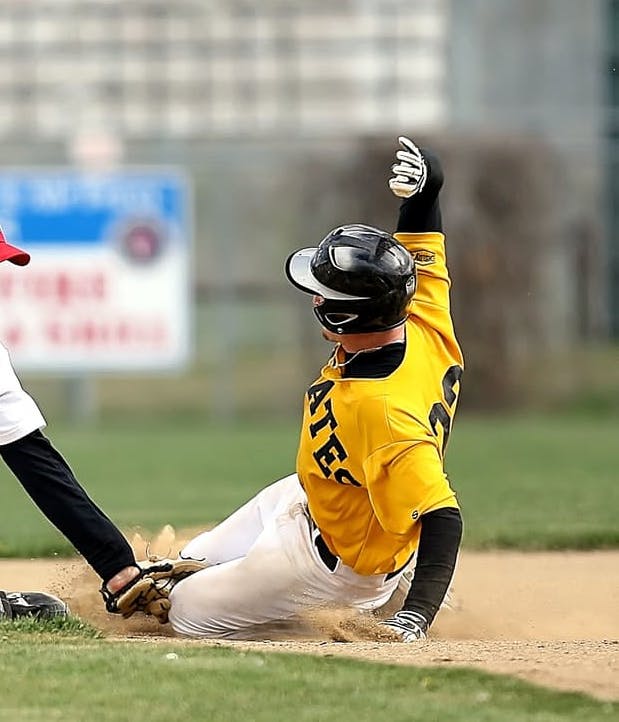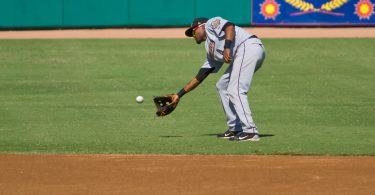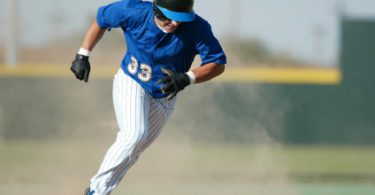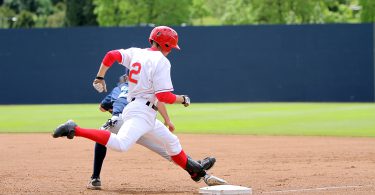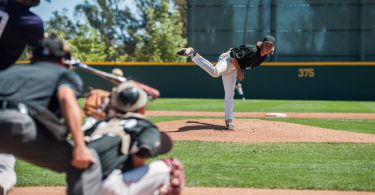The Situation: There are runners on second and third, with one out.
The Play: The batter hits a medium fly ball to right center field. The ball isn’t hit terribly deep, but the angle that the center fielder has to take to make the play doesn’t have his momentum behind the catch and going towards home. The runner at third base goes back to tag up. Seeing the route, he thinks he can make it in spite of knowing the outfielder has a strong arm. When the ball makes contact with the outfielder’s mitt, the runner tags, full-steam ahead. The outfielder makes a clean transition at the chest and fires a missile homeward.
The Outcome: The ball and runner enter the home plate circle at just about the same time, with the ball arriving to the catcher on target. The runner slides in early and straight to home. He extends his lead leg, but as it touches down in the dirt a foot and a half from home, it curls back up to the bent leg, and the runner goes into home knees first. The back, bent leg touches home first, but not before the runner is tagged out to end the inning.
What Went Wrong:
Think about how many close sliding plays you see each year. Diving back on pickoffs, plays at the plate, steal attempts, trying to stretch for an extra 90—all of them. Is there 1 a game? More? Now, think about how much time you have invested thinking about and practicing how to slide. What if you could turn some of those sliding outs into safe calls? Could it make a difference in an offensive inning? The result in a game? A season? It might not be as far-fetched as you think.
Slides are severely underrepresented in most practice plans and as a result, even at the big league level, we see non-competitive or poor slides on a regular basis. Controlling your body during a slide and having a number of different slides in your arsenal can make a huge difference in outcomes and avoiding tags. Watch this play unfold, starting at the 17 second mark. What do you think of the slide? Could the runner have made a better attempt at being safe? Whether or not it would have changed the outcome, we think that he could have.
Here are a few things that went wrong on this slide:
- The runner slid too early, and the lead leg couldn’t extend towards the plate.
- The back leg touches home, meaning on a better slide he could have got there quicker (pause the play at 23 second and ask yourself if the front leg was extended if that is an automatic out).
- The runner didn’t control his body in the slide, and loses balance through the tag.
- Had the runner slid wide of the plate on the back side and reached for the plate with his hand, could the tag have been applied?
Hindsight is always 20-20, but the point is that being able to slide well and control your body (swim an arm back, lean one way or another with the torso, slide on both sides and reach with a leg or arm, etc) is an offensive tool. So how can you change this? Work on sliding. Work on diving. Work on reading the receiving fielder’s position and using it to guide your route to a base or home plate. Coaches, ask yourself if working more on sliding during practice might be worthwhile. Even planting the seed of importance in your players’ minds can get them to value a good slide more. Call good slides out when you see them, so that players know you value their effort. Players, ask yourself if you practice your sliding during all the chances you get or whether you prefer not to get dirty or scraped up during practice. Work on it. Visualize it. Watch video of different slides and techniques to use in your game. With a little bit of effort and attention, you can think the game on a higher level and slide your way to success on the bases.

